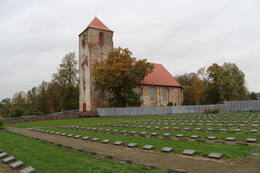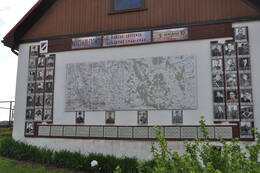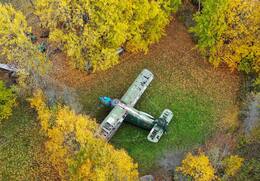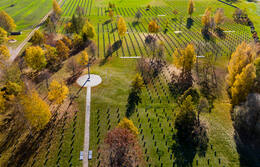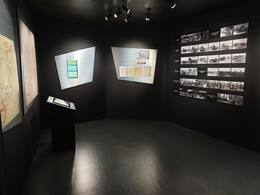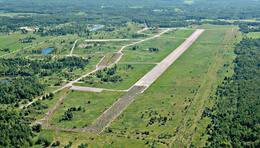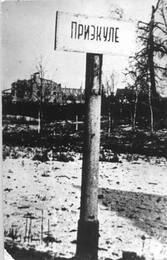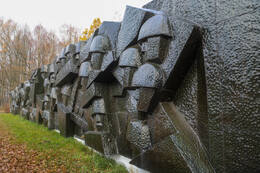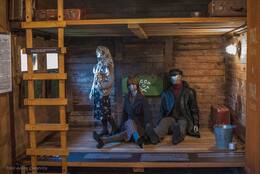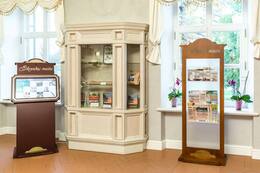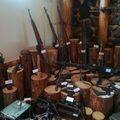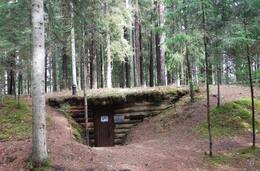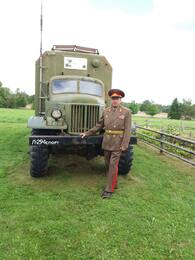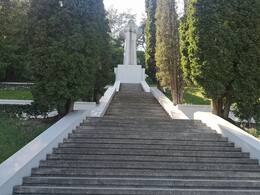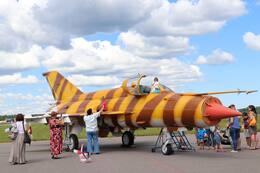Nuo Kuržemės katilo mūšio iki sovietinio paveldo nuotykių Dundagoje
Lestenės brolių kapinės
Įsikūręs Tukumo rajone, Lestenėje, šalia bažnyčios.
Masinio kapo kūrimas Lestenėje pradėtas 1998 m. Tai antros pagal dydį karinės kapinės Latvijoje, kuriose palaidota daugiau nei 1300 Latvijos legionierių. Tik atkūrus Latvijos Respubliką atsirado galimybė perlaidoti Antrajame pasauliniame kare žuvusius Latvijos karius iš įvairių vietų.
Latvijos legionas buvo Vokietijos armijos kovinis dalinys, suformuotas daugiausia iš neteisėtai mobilizuotų Latvijos gyventojų. Kareiviai savo buvimą legione suvokė kaip kovą už Latvijos nepriklausomybės atkūrimą, nepaisant to, kad ji vyko Vokietijos ginkluotųjų pajėgų gretose, o Vokietija buvo okupavusi Latviją. Nebuvo jokios kitos karinės jėgos, kuri galėtų atidėti sovietų okupacijos sugrįžimą. Latvijos legionieriai kovojo prieš Raudonąją armiją, kuri likvidavo Latvijos nepriklausomybę, sunaikino jos armiją ir įvykdė nusikaltimus prieš civilius gyventojus. Vokietijos armijos gretose kovojo apie 110 000–115 000 kareivių, apie 30 000–50 000 iš jų žuvo mūšio laukuose.
Šiais laikais Lestenėje galite aplankyti Brolių kapą, šalia kurio stovi Lestenės bažnyčia. Tai išskirtinis baroko sakralinio meno pavyzdys. Senovinėje bažnyčios smuklėje galite susipažinti su paroda, skirta Latvijos legiono istorijai. Centrinį brolių kapo atvaizdą „Tėvynė – Motina – Latvija“ sukūrė skulptorė Arta Dumpė. Netoliese yra Lestenės dvaras, kuris iki Antrojo pasaulinio karo priklausė Latvijos armijos generolui Mārtiniui Hartmaniui.
Ekskursijas po Lestenės bažnyčią galima užsisakyti pas Lestenės evangelikų liuteronų bažnyčios parapijos kunigą Inguną Kokiną, tel. +371 29993743.
Lestenės brolių kapinės, memorialinė ekspozicija ir bunkeris
Lestenės brolių kapinės yra Tukumo savivaldybėje, Lestenėje, šalia Lestenės bažnyčios. Brolių kapinių Lestenėje statyba pradėta 1998 m. Tai antros pagal dydį karinės kapinės Latvijoje, jose palaidota daugiau nei 1300 Latvijos legionierių. Tik atgavus nepriklausomybę atsirado galimybė perlaidoti Antrojo pasaulinio karo metu žuvusius Latvijos kareivius. Latvijos legionas buvo Vokietijos armijos kovinis dalinys, sudarytas daugiausia iš nelegaliai pašauktų latvių. Kareiviai savo buvimą legione laikė kažkuo, ką reikia padaryti norint atkurti Latvijos nepriklausomybę, nepaisant to, kad jie tarnavo Vokietijos ginkluotosiose pajėgose ir kad Vokietija buvo okupavusi Latviją. Latvijos legionieriai kovojo prieš Raudonąją armiją, kuri sunaikino Latvijos nepriklausomybę ir jos armiją bei vykdė nusikaltimus prieš civilius gyventojus. Vokietijos armijos gretose kovojo nuo 110 000 iki 115 000 kareivių, o apie 30 000–50 000 iš jų niekada nepaliko mūšio lauko. Brolių kapinių pagrindinę temą „Tėvynė – Motina – Latvija“ sukūrė skulptorė Arta Dumpė. Kitoje kelio pusėje, buvusiame smuklėje, įrengta ekspozicija, skirta Latvijos legiono istorijai. Šalia jos Latvijos karininkų asociacijos vyrai, vadovaujami kapitono Jānio Slaidinio, pastatė požeminį bunkerį, kuriame parodyta, kaip kareiviai ir karininkai gyveno fronto linijose.
Kuržemės tvirtovės muziejus Zante
Bus atidaryta nuo gegužės 1 d.
Pasiplaukiojimas laivu „Zezer“ Ciecerės ežere
Kelionės pramoginiu laivu „Zezer“ Ciecerės ežeru netoli Brocėnų metu galėsite klausytis audiogido ir kapitono pasakojimų apie Ciecerės ežerą ir Brocėnų miestą prie jo krantų, Antrojo pasaulinio karo įvykius prie Ciecerės ežero, apkasus abiejose ežero pusėse ir Ąžuolų salą, taip pat tankų maršrutą, vedantį palei apžvalgos bokštą ir tanką, kuris, kaip teigiama, yra nuskandintas ežere. Audiogidas pateikiamas latvių, lietuvių, anglų ir rusų kalbomis. Kelionė trunka 1 valandą 15 minučių.
Saldaus vokiečių kareivių kapinės
Saldaus vokiečių kareivių kapinės yra prie Saldaus–Ežerės plento. Kapinėse, užimančiose 8 hektarų plotą, yra apie 25 000 vokiečių kareivių, taip pat kai kurių Latvijos legionierių palaikai. Perlaidojimai vyksta nuo 1997 m.
Nuo gegužės 1 d. iki spalio 1 d. memorialiniame kambaryje galima apžiūrėti parodą apie Kuršo mūšius. Šiuo laikotarpiu memorialinis kambarys dirba darbo dienomis nuo 9:00 iki 17:00 val., o šeštadieniais ir sekmadieniais kapinėse dirba ir gidas. Taip pat galima susipažinti su Saldaus vokiečių kareivių kapinėse palaidotų ir visoje Latvijoje žuvusių kareivių sąrašais.
Ezerės kraštotyros saugykla „Muitas Nams“
Ezerės muitinė yra Ezerėje, netoli Saldaus-Mažeikių plento, Latvijos ir Lietuvos pasienyje. 1945 m. gegužės 8 d. šiame pastate buvo pasirašytas vadinamojoje „Kuršo kišenėje“ apsuptų Vokietijos armijos dalinių „Kurzeme“ (Kurlandas) kapituliacijos aktas. Manoma, kad Antrasis pasaulinis karas iš tikrųjų baigėsi Ezerėje. Muitinėje yra ekspozicija, kurioje aprašomi Antrojo pasaulinio karo pabaigos įvykiai, ir eksponatai, kuriuose išsamiai aprašoma Ezerės parapijos istorija nuo seniausių laikų iki šių dienų. 1945 m. gegužės 7 d. rytą Leningrado fronto vadas maršalas L. Govorovas išsiuntė armijų grupės „Kurzeme“ vadovybei ultimatumą sudėti ginklus. Kapituliacijos aktą susijusios šalys pasirašė gegužės 8 d., jame išsamiai aprašyta perdavimo tvarka, ginklų surinkimo punktai, pateiktini dokumentai ir informacija bei kitos praktinės priemonės.
Vainodės oro bazė
Vainodės aerodrome vis dar yra 16 sovietmečio orlaivių angarų ir 1800 m ilgio kadaise 2500 m ilgio tako atkarpa. Aerodromą galima aplankyti tik iš anksto užsiregistravus. Vainodės aerodromas buvo įkurtas Latvijos nepriklausomybės metais kaip vienas iš Latvijos aviacijos lopšių, o vėliau tapo vienu didžiausių karinių aerodromų Baltijos šalyse. 1916 m. buvo pastatyti du angarai Vokietijos armijos dirižabliams. Dirižabliai buvo naudojami žvalgybai rinkti ir Rusijos armijos pozicijoms bombarduoti. Vėliau Rygos miestas įsigijo dirižablių angarus ir panaudojo jų stogo konstrukcijas Rygos centrinio turgaus paviljonams pastatyti. 1940 m. gegužę į Vainodę persikėlė 31-asis Raudonosios armijos greitųjų bombonešių aviacijos pulkas ir pradėta standartizuoto betoninių plokščių tako statyba. 1944 m. vasaros pabaigoje nebaigtu aerodromu naudojosi įvairūs vokiečių aviacijos daliniai, tačiau Antrojo pasaulinio karo pabaigoje tą patį aerodromą naudojo Raudonosios armijos aviacijos daliniai, kovoję su vokiečių armijos grupuote „Kurzeme“. Po Antrojo pasaulinio karo Sovietų Sąjungos oro pajėgos Vainiodėje buvo dislokuotos iki 1992 m.
Priekulės karių kapinių memorialinis ansamblis
Priekulės karių kapinių memorialinis ansamblis yra Liepojos-Priekulės-Skodos kelyje ir yra didžiausia Antrojo pasaulinio karo sovietų karių laidojimo vieta Baltijos šalyse. Čia palaidota daugiau nei 23 000 sovietų karių. Operacija „Priekulė“ buvo vienas įnirtingiausių mūšių Kuržemės tvirtovėje, vykęs nuo 1944 m. spalio iki 1945 m. vasario 21 d. Priekulės mūšis 1945 m. vasarį truko septynias dienas ir naktis be perstojo ir pareikalavo daug aukų abiejose pusėse. Iki Priekulės karių kapinių pavertimo memorialu čia buvo pastatytas paskutinis iškilaus latvių skulptoriaus K. Zālės (1888–1942) paminklas, skirtas Alojos nepriklausomybės kovoms atminti. Nuo 1974 iki 1984 m. 8 ha Priekulės karių kapinės buvo paverstos memorialiniu ansambliu, skirtu Antrojo pasaulinio karo žuvusiems. Jį suprojektavo skulptorius P. Zaļkalne, architektai A. Zoldners ir E. Salguss bei dendrologas A. Lasis.
Memorialo centre stovi 12 m aukščio statula, vadinama „Tėvyne“, o žuvusiųjų vardai iškalti granito plokštėse. Iki Latvijos nepriklausomybės atgavimo Pergalės diena buvo plačiai švenčiama kasmet gegužės 9 d.
Trėmimams naudotas galvijinis vagonas – muziejus Skrundos geležinkelio stotyje
1941 m. birželio ir 1949 m. kovo mėn. trėmimams atminti Skrundos geležinkelio stotyje pastatytas atminimo akmuo ir keturašis vagonas, kuris taip pat tarnauja kaip trėmimams skirtas muziejus. Tai pirmasis vagono tipo muziejus Latvijoje, kuriame nuolat eksponuojamos iš Skrundos stoties ištremtų žmonių nuotraukos, laiškai, atsiminimai, dokumentai ir įvairūs daiktai. Skrundos stotis buvo tremtinių surinkimo vieta ir viena iš trijų regiono stočių, į kurią buvo atvežti žmonės iš Skrundos ir Kuldygos apylinkių. 1941 m. iš čia į Krasnojarsko kraštą Sibire buvo ištremta pirmojo atkurtos Latvijos Respublikos prezidento Gunčio Ulmanio šeima.
Deportacijų pagalba sovietai susidorojo su nacionalinių partizanų šalininkais ir tuo pačiu metu baugino likusius kaimo gyventojus, versdami juos stoti į kolūkius.
Skrundos dvaras ir Skrundos lokatoriaus ekspozicija
Skrundos dvare įrengta ekspozicija apie Skrundos radarą (Skrundos radijo lokacijos stotį) ir Latvijos liaudies fronto veiklą Skrundoje. Skrundos radijo lokacijos stotis, pravarde „Kombināts“ (Gamykla), buvo SSRS raketų ankstyvojo perspėjimo sistema vakariniame sektoriuje. Vietovė „Skrunda-2“ buvo specialus miestas (V/ч 18951), įkurtas 5 km nuo Skrundos Kuldygos kryptimi SSRS kariuomenės reikmėms. Iš čia veikė radaro stotis „Dnepr“ ir buvo statoma nauja, modernesnė stotis „Darjal“. Statybos buvo sustabdytos, o radaro stotis „Darjal“ susprogdinta 1995 m. gegužės 4 d. Laikantis tarptautinio susitarimo, radaro stotis „Dniepras“ buvo uždaryta 1998 m. rugpjūčio 31 d.
Pelci dvaras
Pelčių dvaras yra Pelčių valsčiuje, Kuldygos savivaldybėje. Ekskursijas po dvaro rūmus būtina užsisakyti iš anksto. Pelčių dvaras buvo pastatytas 1903–1904 m., o šis architekto Vilhelmo Neumano kūrinys yra vienas iškiliausių XX a. pradžios dvarų Latvijoje. Jo architektūrinė kalba apima kompozicinius principus ir Renesanso, baroko bei Art Nouveau elementus. Nuo XIX a. pabaigos iki 1920 m. dvaras priklausė pirmųjų Lievenų šeimai.
Nuo 1944 iki 1945 m. Pelčų dvare buvo įsikūręs Vokietijos armijų grupės „Šiaurė“ (nuo 1945 m. sausio 25 d. – armijų grupė „Kurzeme“) štabas.
Armijų grupės „Šiaurė“ štabas 1944 m. rugsėjo 23 d., atsižvelgiant į planuojamą 18-osios armijos pajėgų atsitraukimą iš Estijos, persikėlė iš Siguldos į Pelčų dvarą. Štabas ten išbuvo maždaug iki 1945 m. gegužės vidurio, kai, po armijų grupės „Kurzeme“ kapituliacijos, informacija ir dokumentai buvo perduoti Raudonosios armijos karininkams.
Rendos nacionalinio pasipriešinimo judėjimo muziejus
Muziejus yra įsikūręs už kelių kilometrų nuo Rendos parapijos centro. Parodoje pasakojama apie 50 metų trukusį pasipriešinimo judėjimą Latvijoje: pasipriešinimą pirmajai sovietų okupacijai, pasipriešinimą nacistinės Vokietijos okupacijai ir ginkluotą bei nesmurtinį pasipriešinimą sovietų okupacijai. Paroda įsikūrusi dviejuose pastatuose. Pirmajame pastate saugomi pirmosios sovietų ir vokiečių okupacijos įrodymai. Parodoje eksponuojamas restauruotas tvarto pastatas, kuriame dėmesys sutelktas į Nacionalinį partizaninį karą. Tarp dviejų pastatų yra autentiško išplanavimo bunkeris ir kareivių naudoti apkasai. Netoli muziejaus Rendoje esantys kasinėjimai, blindažo aikštelė ir kliūčių ruožas tarnauja kaip jaunimo sargybinių ir visų susidomėjusiųjų treniruočių aikštelė. Apsilankymus būtina užsisakyti iš anksto.
Vienas didžiausių nacionalinių partizanų mūšių, vadinamas Āpūzniekų mūšiu, įvyko 1946 m. sausį netoli čia. Mūšyje Kabilės nacionalinis partizanų būrys nugalėjo daug didesnes okupacinės valdžios pajėgas. Mūšio vietoje, kurioje yra informaciniai stendai, dabar įrengta poilsio aikštelė.
Rubenio bataliono bunkeris ir mūšio laukai
Restauruotas Rubenio bataliono 2-osios kuopos žeminė yra miške prie Ilziki ežero Usmos valsčiuje. Žeminę galima apžiūrėti iš išorės nemokamai bet kuriuo metu. Tačiau ekskursijas žeminės viduje būtina užsisakyti iš anksto.
Leitenanto Roberto Rubenio batalionas buvo generolo Jānio Kurelio suformuoto karinio dalinio dalis ir žinomas dėl to, kad nepasidavė vokiečių kariuomenei ir demonstravo didelį pasipriešinimą. 1944 m. lapkričio 14–gruodžio 9 d. Ugalės, Usmos, Rendos ir Zlėkų valsčiuose vyko įnirtingi mūšiai tarp 16-osios Vokietijos armijos, SD ir SS dalinių, vadovaujamų policijos generolo Friedricho Jeckelio, ir Kureliečių dalinio bataliono, vadovaujamo leitenanto Roberto Rubenio. Rubenio vadovaujami vyrai buvo gerai ginkluoti ir organizuoti, nesiejo savęs su jokia iš dviejų priešiškų okupacinių jėgų. Jų veiksmai laikomi plačiausiais ir ilgiausiais Latvijos nacionalinio pasipriešinimo judėjimo istorijoje. Mūšiuose prie Rendos ir Zlėkų žuvo apie 250 vokiečių kareivių, o Rubenio vyrai patyrė tik 50 aukų. Tų dienų įvykius simbolizuoja miške atkurta žeminė (velėna dengta, žemėje iškasta rąstinė trobelė), kurioje kadaise buvo apsistoję Rubenio bataliono vyrai.
Rubenio bataliono muziejus
Rubenio bataliono muziejus yra Ugalėje. Jis skirtas R. Rubenio batalionui, kuris 1944 m. tarnavo ir kovojo Kuržemėje vadovaujant generolui J. Kureliui, kurelių veiklai ir nacionaliniam pasipriešinimo judėjimui. Muziejuje yra ekspozicija apie Latvijos Centrinės Tarybos (LKT) ir jos Ventspilio grupės veiklą, taip pat LKT memorandumas su 188 parašais ir signatarų nuotraukomis, įtrauktas į UNESCO programos „Pasaulio atmintis“ Latvijos nacionalinį registrą. LKT buvo bendras Latvijos aukščiausios politinės vadovybės ir pogrindinės vyriausybės, veikusios Latvijos okupacijos metu nuo 1943 iki 1994 m., centras. Jis buvo įkurtas siekiant koordinuoti įvairių Latvijos pasipriešinimo judėjimų veiklą, siekiant atkurti Latvijos nacionalinę nepriklausomybę. Muziejus taip pat siūlo kelionę į bataliono istorijai reikšmingas vietas (gyvenvietę su rekonstruotu bunkeriu Usmos valsčiuje, mūšio laukus Rendos ir Zlėkų valsčiuose ir kt.).
Sovietų armijos automobilių kolekcija
Edgaras Kārklevalkas Dundagos rajone valdo svečių namus „Pūpoli“ ir jau daugiau nei 15 metų savo restauruotu sovietinės armijos sunkvežimiu GAZ-66 (iki 24 asmenų) ir UAZ-3151 (iki 6 asmenų) veda žmones į istorines ir edukacines keliones po šiaurinę Kuržemę (įskaitant buvusias karines teritorijas). Sovietinės armijos sunkvežimiai ir kita įranga eksponuojami aplink svečių namus esančioje teritorijoje.
Sovietinis memorialas „Motina – Tėvynė“ Tukume
Tukume esantis Antrojo pasaulinio karo brolių kapinių memorialas yra vienas didžiausių sovietmečio memorialų Latvijoje. Jis yra Kalno kapinėse ir yra matomas nuo Revoliucijos gatvės. Memorialas buvo atidengtas sovietų okupacijos metu 1985 m., minint Raudonosios armijos pergalę prieš Vokietiją. Jis skirtas tiems, kurie įvairiais laikais žuvo vardan sovietų valdžios. „Motina – Tėvynė“ buvo vienas iš dažniausiai naudojamų vaizdinių, kuriant daugelį memorialų. Paminklas buvo naudojamas komunistinei ideologijai ir propagandai perteikti, simboliškai sustiprinant okupacinio režimo buvimą Latvijoje. Po Vokietijos kapituliacijos Raudonoji armija Kuržemę laikė iš priešo atimta teritorija, o ne išlaisvinta SSRS dalimi. Represinė valdžia ir armija pradėjo „Kuržemės valymą“. 16–60 metų vyrai buvo sulaikomi, registruojami ir tikrinami. Kuržemės vyrai buvo laikomi tokiais pat pavojingais, kaip ir buvusios Vokietijos armijos kariškiai. Tai buvo Raudonosios armijos nusikalstamumo bangos, atnešusios žmogžudystes, išprievartavimus, vagystes, areštus ir „paslaptingus žmonių dingimus“, pradžia. Ginkluotą pasipriešinimą demonstravo tik nacionalinės partizanų grupės. Sovietų valdžia įkūrė naikinimo batalionus (taip pat ir Tukume), kad pašalintų bet kokį pasipriešinimą. Smurto ir teroro banga pasiekė kulminaciją 1949 m., kai visoje Latvijoje vyko deportacijos.
Aviacijos muziejus „SKY ZOO“
Aviacijos muziejus „Sky Zoo“ yra Smārdės valsčiuje, Tukumo savivaldybėje, Jūrmalos oro uosto teritorijoje, kuri anksčiau buvo Tukumo karinis aerodromas. Ekspozicijoje eksponuojami lėktuvai YAK-40, AN-2, SU22M4, PZL TS-11 Iskra ir sraigtasparnis MI-24. Ekskursijos po aerodromą metu apžiūrimi angarai, kaponieriai ir inžinerinė įranga. Aerodromą naudojo tiek Vokietijos, tiek Sovietų Sąjungos armijos. Sovietų okupacijos metu tai buvo vienas svarbiausių karinių aerodromų Latvijos teritorijoje. Jame dislokuoti naikintuvai buvo skirti atakuoti priešo laivus ir bombarduoti pakrantės įtvirtinimus. 1975 m. lapkričio 9 d. naktį Tukumo aerodrome buvo gautas kovos signalas – Sovietų Sąjungos teritoriniuose vandenyse (Rygos įlankoje) buvo priešo karo laivas, kurį reikėjo sunaikinti. Iš Tukumo pakilo keli lėktuvai. Tačiau paaiškėjo, kad ginkluotas maištas prieš esamą sovietų režimą įvyko sovietų karinio jūrų laivyno karo laive „Storoževoi“ („Globėjas“). Lėktuvams pasiekus karo laivą, mūšis dar tęsėsi. Vėliau sukilėlių vadas Valerijus Sablinas, sovietų karinio jūrų laivyno karininkas, buvo sužeistas, o maištas baigėsi. Jam buvo skirta mirties bausmė už išdavystę. Tai buvo vienas dramatiškiausių įvykių, rodančių nepasitenkinimą režimu ir žyminčių artėjantį jo žlugimą.




